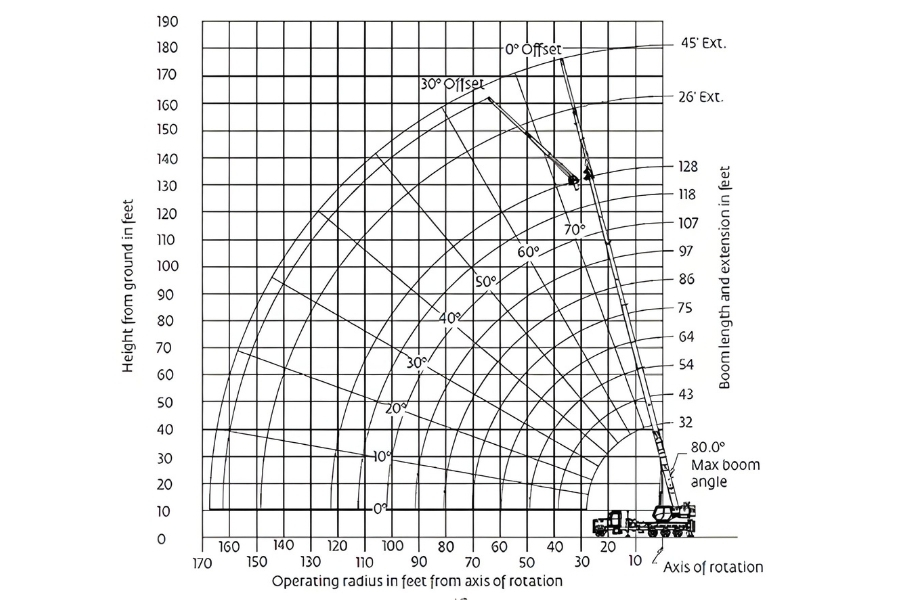Crane load charts are critical tools for safe and efficient crane operations. These charts provide operators with the information they need to determine the lifting capacity of a crane in various configurations. While the numbers and diagrams may seem daunting at first, understanding load charts is essential to avoid accidents, ensure compliance with safety regulations, and optimize crane performance.
In this guide, we’ll break down the components of a crane load chart and explain how to use it effectively.
1. What is a Crane Load Chart?
A crane load chart is a detailed diagram that specifies the maximum load a crane can lift under different conditions. The chart takes into account:
- Boom length
- Radius of the load (distance from the crane’s center to the load)
- Counterweight
- Lift angle and height
By understanding these factors, operators can ensure the crane operates within its safe limits.
2. Components of a Crane Load Chart
To use a load chart effectively, you need to understand its key components:
a. Crane Configuration
The chart specifies the type of boom, jib, and counterweight setup required for different lifting capacities.
b. Boom Length
The boom length affects the lifting capacity. Longer booms generally have reduced capacity due to the increased leverage and weight.
c. Operating Radius
The radius is the horizontal distance between the crane’s center of rotation and the load’s center of gravity. As the radius increases, the lifting capacity decreases.
d. Load Capacity Tables
These tables list the maximum weights the crane can lift at specific boom lengths and radii.
e. Stability Limits
The chart often includes stability limits to indicate when the crane may tip over due to an unbalanced load.
f. Notes and Warnings
Load charts include critical notes about conditions that can affect lifting capacity, such as wind speed and ground stability.
3. Steps to Read a Crane Load Chart
Step 1: Identify Your Crane Configuration
Refer to the chart section that matches the crane’s current setup, including the type of boom and counterweights.
Step 2: Determine the Lift Radius
Measure the horizontal distance from the crane’s base to the load’s center. Find the corresponding radius on the chart.
Step 3: Check the Boom Length
Determine the length of the boom needed for the lift. Cross-reference the boom length and radius to find the maximum load capacity.
Step 4: Factor in the Lift Angle
If the lift involves an angled boom, use the chart to adjust the capacity based on the angle.
Step 5: Account for Safety Margins
Always operate below the maximum capacity to account for unforeseen factors like wind or load instability.
4. Common Mistakes to Avoid
Reading a load chart incorrectly can lead to severe consequences. Avoid these common pitfalls:
- Ignoring Ground Conditions: Soft or uneven ground can reduce stability, even if the chart indicates the lift is safe.
- Overlooking Dynamic Loads: Moving loads can exert additional force on the crane, exceeding chart limits.
- Neglecting Accessories: Attachments like slings and spreader bars add weight, reducing the overall lifting capacity.
5. The Importance of Load Charts in Safety
Accidents in crane operations often stem from exceeding load capacities. Proper use of load charts ensures:
- Stability: Prevents tipping by maintaining a balanced load.
- Equipment Integrity: Avoids overloading that could damage the crane.
- Compliance: Meets regulatory requirements and avoids legal issues.
6. Tips for Effective Load Chart Use
- Training: Ensure operators are trained in reading and applying load charts.
- Regular Inspections: Verify that the crane is in good condition and matches the chart’s specifications.
- Use Technology: Modern cranes often have built-in systems that automatically calculate load capacities based on chart data.
7. Conclusion
Understanding crane load charts is essential for safe and efficient crane operations. By familiarizing yourself with the chart’s components and using them correctly, you can minimize risks, optimize performance, and ensure a successful project.
For expert advice and reliable crane solutions, reach out to 3 Tech Cranes today. Let us help you lift your projects to new heights—safely and efficiently!

